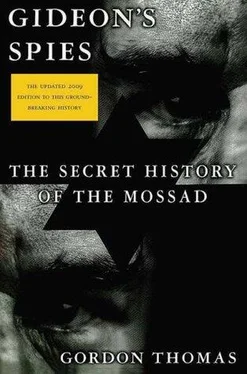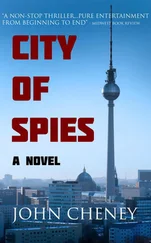Gordon Thomas - Gideon's Spies
Здесь есть возможность читать онлайн «Gordon Thomas - Gideon's Spies» весь текст электронной книги совершенно бесплатно (целиком полную версию без сокращений). В некоторых случаях можно слушать аудио, скачать через торрент в формате fb2 и присутствует краткое содержание. Город: New York, Год выпуска: 2009, ISBN: 2009, Издательство: Thomas Dunne Books, Жанр: История, на английском языке. Описание произведения, (предисловие) а так же отзывы посетителей доступны на портале библиотеки ЛибКат.
- Название:Gideon's Spies
- Автор:
- Издательство:Thomas Dunne Books
- Жанр:
- Год:2009
- Город:New York
- ISBN:978-0-312-53901-6
- Рейтинг книги:4 / 5. Голосов: 1
-
Избранное:Добавить в избранное
- Отзывы:
-
Ваша оценка:
- 80
- 1
- 2
- 3
- 4
- 5
Gideon's Spies: краткое содержание, описание и аннотация
Предлагаем к чтению аннотацию, описание, краткое содержание или предисловие (зависит от того, что написал сам автор книги «Gideon's Spies»). Если вы не нашли необходимую информацию о книге — напишите в комментариях, мы постараемся отыскать её.
Gideon’s Spies
Gideon's Spies — читать онлайн бесплатно полную книгу (весь текст) целиком
Ниже представлен текст книги, разбитый по страницам. Система сохранения места последней прочитанной страницы, позволяет с удобством читать онлайн бесплатно книгу «Gideon's Spies», без необходимости каждый раз заново искать на чём Вы остановились. Поставьте закладку, и сможете в любой момент перейти на страницу, на которой закончили чтение.
Интервал:
Закладка:
When Meir Dagan read her words, he echoed them. Then he and Porter Goss wrote a document that was circulated to European intelligence chiefs. Titled “The Future of Bioweapons,” it concluded: “Al-Qaeda will soon be in a position to create artificially engineered biological agents which can spread disease on an unparalleled scale. The same science which is taught in universities can now be adapted to create the world’s most frightening weapons. We must be aware that al-Qaeda is investing in postgraduate Muslim students on our campuses in the same way it invested in sending the 9/11 pilots to our flying schools.”
There was no more than a polite response from other intelligence chiefs. The feeling was that once again Mossad and the CIA were combining to raise the level of the terrorist threat. This was particularly felt in London where MI5 and MI6 were still irritated by the constant demands from Israel that Britain should curb the activities of radical Muslim preachers allowed to remain in the country. In mosques in London and elsewhere in Britain they openly preached hatred against Israel and the United States.
On a Monday morning in the first week of March 2005, the heads of Israel’s intelligence community drove down Tel Aviv’s Rehov Shaul Hamaleku and turned into the Kirya, the headquarters of the Israeli Defence Forces. They included the director of Shin Bet, the service responsible for internal security; the heads of Air Force and Naval intelligence; the commander of the Sholdag special forces battalion, and the chief of the Research and Political Center that advised the country’s policy makers on long-term strategy. Meir Dagan, in his capacity as menume, which roughly translates from Hebrew as “first among equals,” chaired the meeting. On the agenda was a subject never far from the minds who had assembled in the conference room: Iran.
Every man could recall the years of tension the Islamic Republic had brought to Israel since 1979. Over the ensuing twenty-six years, its policy had been articulated in a huge banner draped above the main entrance to the foreign ministry in Tehran. It bore the chilling words in Farsi: “Israel Must Burn.”
For all those years Iran had been a terrorist-sponsoring nation, with particularly close ties to Hezbollah. Most of the weapons used by that group came from Iran. It was also currently engaged in undermining the fledgling democracy in Iraq by supporting its growing terrorism. Yet the diplomats of Washington’s State Department and Britain’s Foreign Office still clung to the belief that Iran was in a transition period toward democracy, and that there were moderates in the regime who could be persuaded to enter into an “accommodation” with the West and convince Hezbollah and other terror groups to cease their attacks on Israel. Mossad’s eavesdroppers and informers in Gaza had overheard the MI6 team reiterating the claim.
John Scarlett’s continued refusal to withdraw the team had led to an increasing coldness in Mossad’s relationship with MI6. While important intelligence passed between both services on the usual need-to-know basis, Nathan, the London station chief, no longer took a regular cab ride from the Israeli Embassy in Kensington to the glass-faced building overlooking the river Thames, known as “the wedding cake” for its tiered shape, to share a convivial hour with senior MI6 officers over drinks and sandwiches. The occasions were a chance to get to know the thinking within MI6 on a wide variety of issues, and there were lively discussions on what one MI6 officer had called “the current state of play” in Damascus, Riyadh, and Egypt. In that closed world in the hospitality suite on the fifth floor, what was not said was often as important as what was said. Scarlett had sometimes dropped in on those gatherings to inquire how things were in Tel Aviv.
But until the “Gaza business” was settled, contacts with MI6 were to be confined to essentials. Mossad’s mood had not improved when Nathan’s MI6 liaison officer had said that the Hamas team believed it was making good progress in persuading Hezbollah to end its attacks on Israel.
But for the moment the stand-off with London was of less importance than the reason for the meeting. For the men around the conference table, who had helped Israel to survive war and Intifadas, the high-resolution satellite photographs spread before them told a grim story. The images were of Iran’s nuclear facilities filmed only a week before by Israel’s own satellite. They showed the six prime plants that were scattered across the country. Each facility was buried under thousands of tons of reinforced concrete, hard to penetrate with even the BLU-109 “bunker buster” bombs the United States had recently sold to Israel.
Accompanying the images were reports from Mossad’s deep-penetration agents in the country. Their identities were a closely guarded secret between Dagan and his assistant director on the seventh floor of the headquarters building. One agent had revealed that the Natanz facility in southern Iran was working around the clock to enable its fifty thousand centrifuges to eventually produce huge quantities of enriched uranium in its three heavily fortified underground structures. Another report demonstrated how Russia had provided 150 technicians to upgrade the Bushehr nuclear power plant on the Persian Gulf, severely damaged in Iran’s war with Iraq. A third report described the installation at the Sharif University of Technology of centrifuges capable of running a uranium-enrichment program. Yet another report highlighted the capability of the University of Tehran’s nuclear reactor to come on stream in Iran’s drive to build a nuclear bomb. One agent had pinpointed the entrances to underground facilities in the desert fastness of Yazd Province. The most detailed report described a plant on the outskirts of the ancient city of Esfahan. Sited close to the eastern suburbs, the cluster of modern buildings were near the towering Emam mosque and the magnificent eleventh-century bridge over the Zadaneh Rud River along which the carpet weavers of Esfahan have exported their wares for a millennium.
The men around the conference table saw the area around the uranium conversion facility had been recently reinforced, making it the most heavily guarded of all the facilities. A defense perimeter of antiaircraft guns, razor wire, and thousands of heavily armed soldiers now surrounded the plant hewn into a hill. It was its capability to enrich uranium hexafluoride (UF6) gas that was reason enough for Israel’s intelligence community to assemble in the room. The Mossad agent’s report had ended with the revelation that Esfahan’s uranium conversion facility had already produced three tons of UF6 gas. This was sufficient to enrich uranium for civilian nuclear power—which Iran claimed it would be used for—or for the fifty thousand centrifuges at Natanz ninety miles to the northwest to produce a nuclear weapon.
The agent’s report listed other sites where missile production was underway. The largest was Darkhovin, south of the city of Ahvaz. The facility was heavily fortified with two battalions of the Revolutionary Guard. It employed three thousand scientists and engineers. Most of their work was underground building rocket motors. Mu-allimn Kalayeh was sited in the mountains near Qasvin, its uranium enrichment gas centrifuges produced the enriched weapons-grade material for warheads. Saghand was in the remote desert east of Tehran. It employed eight hundred technicians building casings for the rockets. Nekka, near the Caspian Sea, was buried underground; the complex employed over a thousand scientists. Its facilities included a Neutron Source Reactor purchased from North Korea.
A separate report on the table before the intelligence chiefs was from Israel’s own atomic experts. They estimated between fifteen hundred and two thousand centrifuges would create sufficient enriched uranium to manufacture one atomic bomb a year, and that could come as early as 2007, when the Natanz nuclear facility’s centrifuges would all be fully operational.
Читать дальшеИнтервал:
Закладка:
Похожие книги на «Gideon's Spies»
Представляем Вашему вниманию похожие книги на «Gideon's Spies» списком для выбора. Мы отобрали схожую по названию и смыслу литературу в надежде предоставить читателям больше вариантов отыскать новые, интересные, ещё непрочитанные произведения.
Обсуждение, отзывы о книге «Gideon's Spies» и просто собственные мнения читателей. Оставьте ваши комментарии, напишите, что Вы думаете о произведении, его смысле или главных героях. Укажите что конкретно понравилось, а что нет, и почему Вы так считаете.












